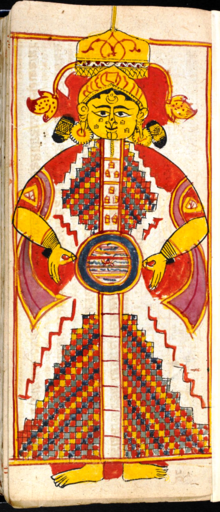
Trailokya (Sanskrit: त्रैलोक्य; Kannada: ತ್ರೈಲೋಕ್ಯ; Pali: tiloka, Tibetan: khams gsum; Chinese: 三界; Vietnamese: Tam Giới) literally means "three worlds".[1][2][3] It can also refer to "three spheres,"[3] "three planes of existence,"[4] and "three realms".[4]
Conceptions of three worlds (tri-loka) appear in Hinduism and Jainism, as well as early Buddhist texts.


Hindu cosmology
[edit]| Part of a series on |
| Hinduism |
|---|
 |
The concept of three worlds has a number of different interpretations in Hindu cosmology.
- Traditionally, the three worlds refer to either the earth (Bhuloka), heaven (Svarga), and hell (Naraka),[5] or the earth (Bhuloka), heaven (Svarga), and the netherworld (Patala)[6]
- The Brahmanda Purana conceives them to be Bhūta (past), Bhavya (future), and Bhavat (present)[7]
- In Vaishnavism, the three worlds are often described to be bhūr, bhuvaḥ, and svaḥ (the gross region, the subtle region, and the celestial region)[8]
- In the Nilanamatapurana, Vamana covers his second step on the three worlds of Maharloka, Janaloka, and Tapoloka, all of which are regarded to be a part of the seven heavens[9]
Buddhist cosmology
[edit]In Buddhism, the three worlds refer to the following destinations for karmic rebirth:
- Kāmaloka the world of desire, typified by base desires, populated by hell beings, preta (hungry ghosts), animals, humans and lower demi-gods.
- Rūpaloka is the world of form, predominantly free of baser desires, populated by dhyāna-dwelling gods, possible rebirth destination for those well practiced in dhyāna.
- Arūpaloka is the world of formlessness, a noncorporeal realm populated with four heavens, possible rebirth destination for practitioners of the four formlessness stages.[3]
Together, they make up all of existence.
Jain cosmology
[edit]The early Jain contemplated the nature of the earth and universe and developed a detailed hypothesis on the various aspects of astronomy and cosmology. According to the Jain texts, the universe is divided into 3 parts:[10][11][12][13]
- Urdhva Loka – the realms of the gods or heavens
- Madhya Loka – the realms of the humans, animals and plants
- Adho Loka – the realms of the hellish beings or the infernal regions
See also
[edit]
Notes
[edit]- ^ Monier-Williams (1899), p. 460, col. 1, entry for "[Tri-]loka" (retrieved at http://www.sanskrit-lexicon.uni-koeln.de/scans/MWScan/MWScanpdf/mw0460-trimala.pdf) and p. 462, col. 2, entry for "Trailoya" (retrieved at http://www.sanskrit-lexicon.uni-koeln.de/scans/MWScan/MWScanpdf/mw0462-tripu.pdf).
- ^ Rhys Davids & Stede (1921-25), p. 301, entry for "Ti-" (retrieved at http://dsal.uchicago.edu/cgi-bin/philologic/getobject.pl?p.1:129.pali[permanent dead link]). Here, tiloka is compared with tebhūmaka ("three planes").
- ^ a b c Fischer-Schreiber et al. (1991), p. 230, entry for "Triloka". Here, synonyms for triloka include trailokya and traidhātuka.
- ^ a b Berzin (2008) renders khams-gsum (Wylie; Tibetan) and tridhatu (Sanskrit) as "three planes of existence" and states that it is "[s]ometimes called 'the three realms.'" Tridhatu is a synonym of triloka where dhatu may be rendered as "dimension" or "realm" and loka as "world" or even "planet."
- ^ www.wisdomlib.org (18 November 2017). "Trailokya: 19 definitions". www.wisdomlib.org. Retrieved 18 August 2022.
- ^ Maruvada, Surya N. (2 March 2020). Who is Who in Hindu Mythology - VOL 2: A Comprehensive Collection of Stories from the Pur??as. Notion Press. ISBN 978-1-64805-686-4.
- ^ www.wisdomlib.org (20 June 2019). "Vaivasvata Manvantara: the Mārīca creation [Chapter 38]". www.wisdomlib.org. Retrieved 18 August 2022.
- ^ www.wisdomlib.org (27 September 2008). "Triloka, Tri-loka: 12 definitions". www.wisdomlib.org. Retrieved 18 August 2022.
- ^ www.wisdomlib.org (28 January 2019). "Story of Vāmana". www.wisdomlib.org. Retrieved 18 August 2022.
- ^ Grimes 1996, p. 177.
- ^ Titze & Bruhn 1998, p. 238.
- ^ Wiley 2009, p. 131.
- ^ Raval 2016, p. 81.
Sources
[edit]- Berzin, Alexander (6 March 2008). Berzin Archives Glossary. Retrieved Sunday 13 July 2008 from "Berzin Archives" at http://www.berzinarchives.com/web/en/about/glossary/glossary_tibetan.html.
- Fischer-Schreiber, Ingrid, Franz-Karl Ehrhard, Michael S. Diener and Michael H. Kohn (trans.) (1991). The Shambhala Dictionary of Buddhism and Zen. Boston: Shambhala Publications. ISBN 0-87773-520-4.
- Monier-Williams, Monier (1899, 1964). A Sanskrit-English Dictionary. London: Oxford University Press. ISBN 0-19-864308-X. Retrieved 2008-07-13 from "Cologne University" at http://www.sanskrit-lexicon.uni-koeln.de/scans/MWScan/index.php?sfx=pdf.
- Rhys Davids, T.W. & William Stede (eds.) (1921-5). The Pali Text Society’s Pali–English Dictionary. Chipstead: Pali Text Society. Retrieved 2008-07-13 from "U. Chicago" at http://dsal.uchicago.edu/dictionaries/pali/.
- W. E. Soothill & L. Hodous (1937-2000). A Dictionary of Chinese Buddhist Terms. Delhi: Motilal Banarsidass. ISBN 81-208-0319-1.
- Grimes, John A. (1996), A Concise Dictionary of Indian Philosophy: Sanskrit Terms Defined in English, SUNY Press, ISBN 9780791430675, retrieved 10 September 2017
- Titze, Kurt; Bruhn, Klaus (1998), Jainism: A Pictorial Guide to the Religion of Non-violence, Motilal Banarsidass Publication, ISBN 9788120815346, retrieved 10 September 2017
- Wiley, Kristi L. (2009), The A to Z of Jainism, Scarecrow Press, ISBN 9780810868212, retrieved 10 September 2017
- Raval, Mukundchandra G. (2016), Meru: The Center of our Earth, Notion Press, ISBN 9781945400100, retrieved 10 September 2017
External links
[edit]- Bullitt, John T. (2005). The Thirty-one Planes of Existence. Retrieved 2007-04-30 from "Access to Insight" at http://www.accesstoinsight.org/ptf/dhamma/sagga/loka.html.